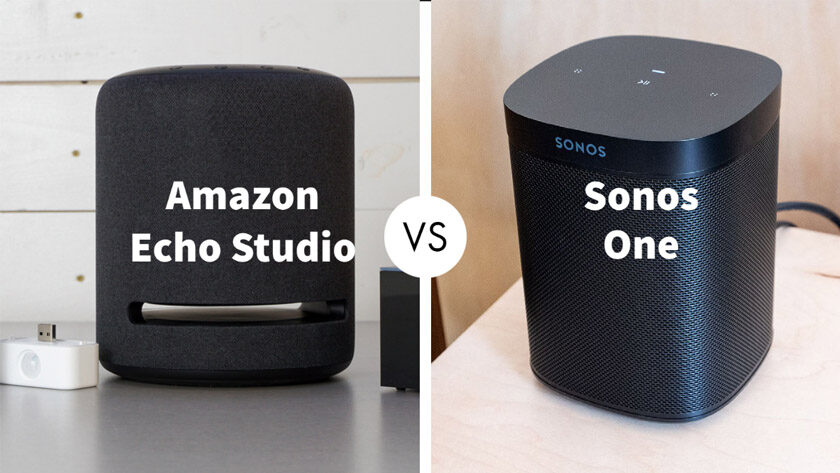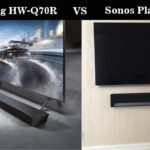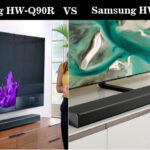Launched in 2019, the Echo Studio from Amazon is part of the very popular Echo series line. Powered by the Alexa Assistant, the Echo Studio is arguably one of the best Echo smart speaker units for audiophiles. It features the Dolby Atmos surround-sound, which means that you can also use it as a TV speaker if you don’t have a soundbar. The Sonos One, on the other hand, is a bit older (released in 2017), however, it has still managed to be one of the best smart speakers around to date. It comes with both Google and Alexa Assistant support as well as unmatched audio quality. It’s one of the Sonos speakers that can be connected to other speakers for seamless multi-room sound, without having annoying cords trail all over your house.
Both speakers have pretty high specs, and in all honesty, either of them would make a fantastic addition to literally any smart home setup. Sadly, though, that doesn’t help make choosing between the two easier. That said, let’s take a closer look at both of them and try to see which one is better.
DESIGN
Echo Studio:
With a diameter of 6.9-inches and a height of 8.1-inches, the Amazon Echo Studio speaker basically looks somewhat of a jacked-up Apple HomePod speaker (5.6×6.8 inches) and makes its Sonos One counterpart look positively dainty. Aside from how big it generally is, the Echo Studio’s most defining feature is its tiny horizontal opening that’s about an inch up from the bottom. This allows sound to spread out better from the speaker’s downward-firing. Just like the Echo, the Studio also has a light ring that circles the top of the speaker which turns blue when you activate Alexa. But, that’s not all. It also has four buttons; one for Alexa activation, one for mic muting and two for volume, just like its other Amazon smart speaker counterparts.
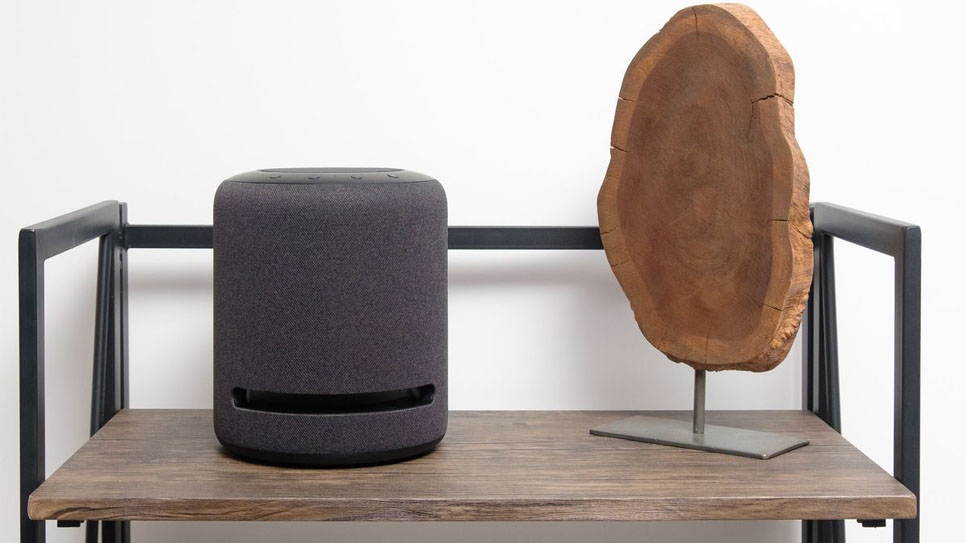
Inside the Amazon Echo Studio unit, you will find the aforementioned singular 1-inch tweeter, three 2-inch midranges and a single 5.25-inch woofer. The Echo Studio, unlike the Sonos One, has an optical-in/line-in port that allows you to connect the speaker to the TV, meaning you can use the Echo Studio for your TV audio in the event you don’t have a soundbar. The Echo Studio speaker can also be connected via Wi-Fi connectivity to a 2nd or 1st gen Fire TV Cube, 3rd gen Fire TV or 4K Fire TV Stick, so that you can have other ways to get even better TV audio.
Sonos One:
The Sonos One and original Play:1 have somewhat of a similar design. However, even though they share many similarities on the design end, the company has tried its best to make as many improvements as possible. For starters, the Sonos One’s touch-sensitive surface, which is found at the top, is a lot sleeker than the one the pause play and volume button trio the Play:1 has. Right, and left swipes are for skipping forward and backward through music playlists. Tapping the center will either pause or play music. Lastly, you can raise or reduce volume by tapping the device’s right and left halves.
This series of controls isn’t that hard to understand for most people, but, just like you would with a lot of the other Sonos smart speakers, you’ll probably relying a lot on the Sonos app itself to control whatever you want or need to control. Yes, the physical controls themselves can come in handy when you want to move from track to track quickly, however, you’re probably not going to use them as much as you think, especially considering you’ll now have access to voice control features which help make things so much easier.
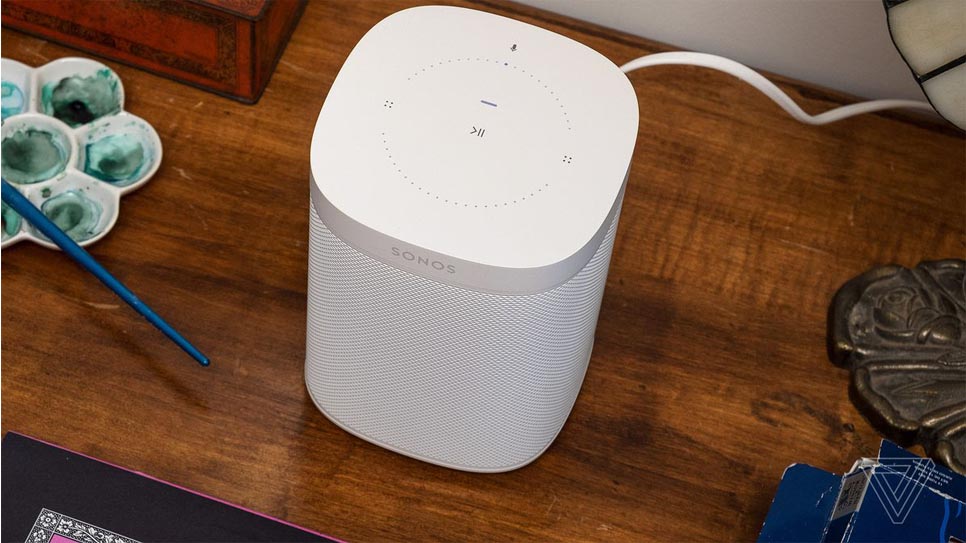
The voice control in the Sonos One is facilitated by 6 microphones that have been built into the device. These mics are what the Sonos uses to hear your drunken requests. Playing “Hey there, Delilah” over and over again has never been easier. The 6 microphones are connected by the same things that connects the insides of its Sonos Play:1 counterpart. This includes tweeter/mid combo accompanied by 2 Class-D amps. There’s also an LED at the top that indicates when the device is on and a tiny light beside it that indicates when Alexa is listening and ready to go. The second LED connects to the Sonos’s microphones, and the company assures consumers that the device won’t be listening until this feature lights up.
SOUND PERFORMANCE
Echo Studio:
The Amazon Echo studio unit was designed to compete with the other higher-end smart speaker units on the market, such as the Sonos One and the like. I guess you could say that Amazon was trying to show that they could provide the world with top-tier smart speaker features at a fraction of the price. Anyway, the Echo Studio manages to deliver excellent audio quality, with a more resonant, deeper bass sound than what’s produced by its Sonos One counterpart. However, music as a whole sound way less defined on the Echo Studio than it does on the Sonos One.
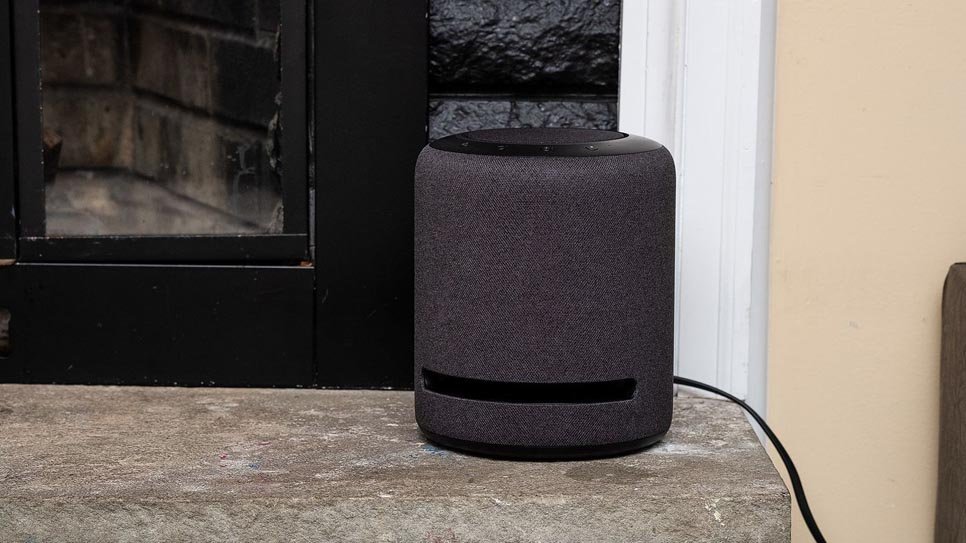
When you use the Spotify application on your smartphone to play music, say classics such as Michael Jackson’s “Thriller”, Wham’s “Last Christmas”, Notorious B.I.G’s “Big Poppa” and “Nat King Cole’s “Monalisa”, the higher-end tones and vocals aren’t as present and sharp on the Amazon Echo Studio as they are and the Sonos One unit. But, the bigger woofer on the Studio smart speaker produces way more resonant bass sounds than its Sonos One counterpart. You can feel the bass from across the room with the Echo Studio. In fact, it has the ability to make someone want to get and start dancing. This is even more evident when you play tracks that have high bass sounds. Though, unfortunately, the voice work on such songs won’t be as noticeable on the Studio unit as they would on the Sonos One.
One of the Echo Studio features that Amazon is always touting to consumers is the smart speaker unit’s ability to play both 3D audio as well as Ultra HD music. 3D audio is where tracks have been remastered via Sony 360 Reality Audio or Dolby Atmos technology to add a bit of depth as well as the sense of all the music instruments filling up the room. In the Amazon Music applications, tracks will have either and Ultra HD or HD icon beside their names. However, you can’t know whether a track has been 3D Audio remastered until you play it.
If you want to listen to high-definition songs, then you’ll have to pay for an Amazon Music HD subscription, which goes for about $12.99 /month if you’re an Amazon prime member and $14.99 /month for everybody else. This is 5 bucks more than Amazon Music Unlimited service, which only offers tracks in standard definition.
Sonos One:
The Sonos One smart speaker offers up excellent overall sound quality, however, that shouldn’t surprise you too much considering it’s a product that has been designed and manufactured by Sonos. They’re one of the best companies in the industry to have ever done it. Coldplay’s “Paradise” has a lot of energy and punch, in fact, it almost feels like the band is performing in your living room. Truth is, it packs quite a serious punch for something so small, and it even does well with the more advanced music pieces. Michael Jackson’s “Thriller” sounds incredibly crisp and clear, despite the different tones and instruments that run throughout the song.
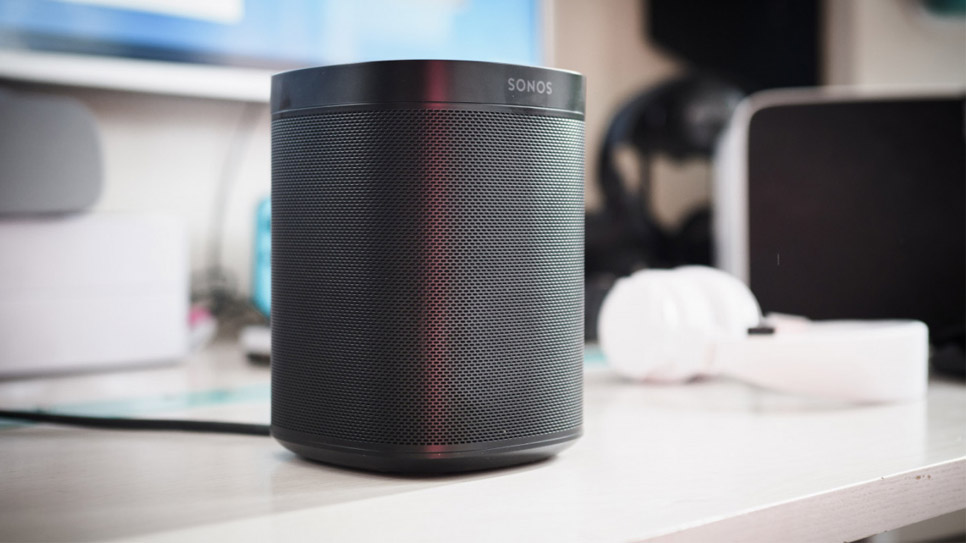
With that said, this smart speaker doesn’t have that separation you get when you’re listening to stereo speakers. All the songs sound like they’ve been squashed into a single channel, though for something this tiny that costs way less than what most of its competitors do, it has managed to really come through.
SETUP
Echo Studio:
Setup is pretty straightforward with the Echo Studio. After you’ve unboxed the device, place it where you want it to stand and then plug it in. Most people like placing it on their entertainment console or kitchen counter. Once you’re done with placement, use the Alexa application (iOS and Android)to connect the device to your home network. During the setup procedure, the smart speaker will play several different tones, and then it’ll proceed to automatically adjusting its acoustics to fit the space it’s been put in.
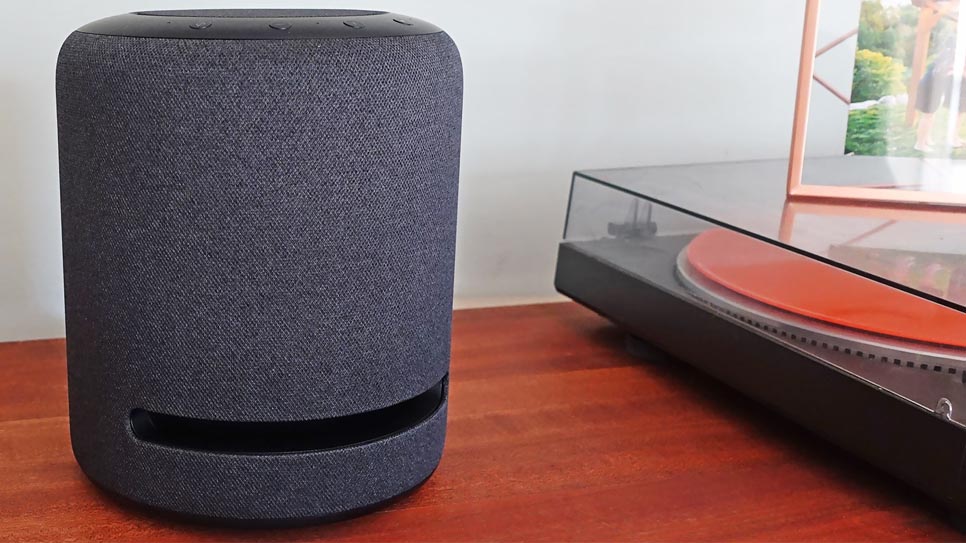
The Sonos One’s TruePlay works kind of the same way, however, with the TruePlay you’ll be required to walk around the space, with a smartphone in hand, for around 45 to 55 seconds or so. That being said, it still manages to get the job done in a faster and much easier way. Once the acoustics have been set, you’re good to go. You can start playing music and dancing to your favorite tunes.
Sonos One:
Unlike the Amazon Echo Studio, the Sonos One’s setup is more involved thanks to the Sonos and Amazon services combination. It’s not as simple and straightforward as it is with the Echo Studio. The procedure here requires the user to install both the Alexa app accounts as well as Sonos app. This will need them to log into their Amazon account and their Sonos account, as well as the other streaming services you like using. You’ll also need to do some ‘TruePlay’ Tuning. This will require the use of your smartphone and you to walk around the space where the Sonos is so it can play some test sounds. Your smartphone will then pick up how the smart speaker sounds in the given surrounding and then it’ll tune the sound accordingly.
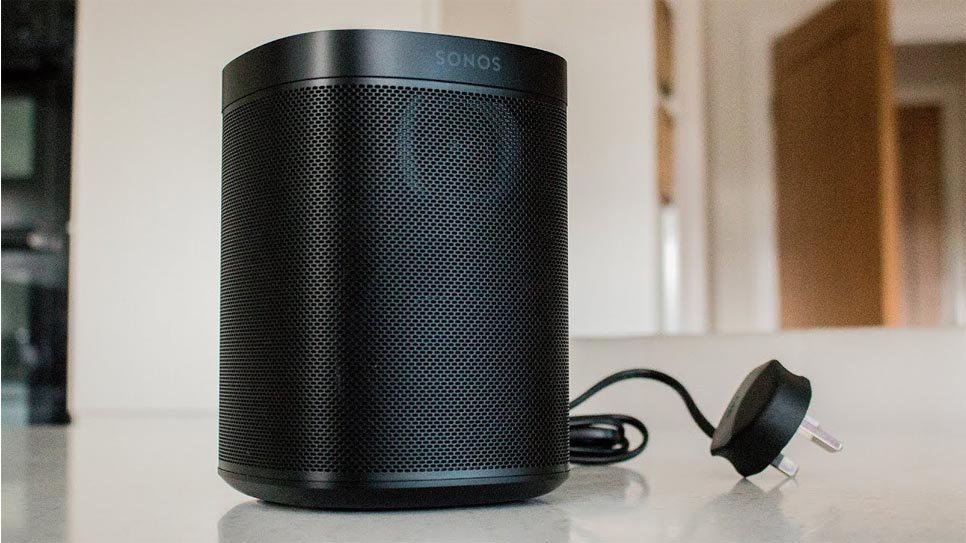
Yes, you can manually adjust both treble and bass if you’ve got certain specific sound preferences you’re looking for, however, the unit’s default setting normally tend to be enough for most folks out there. Unfortunately, though, you won’t be able to pair your Sonos One device with other Play:1 speakers, even though they have the same form-factors.
FEATURES
Echo Studio:
The Amazon Echo Studio, via the Alexa app, supports TuneIn, iHeartRadio, SiriusXM, Pandora, Deezer, Tidal, Spotify, Apple music and, of course, Amazon Music. As much as this is quite a nice mix, it’s still way less than the 100-plus stations that can be streamed via the Sonos app.
The Echo Studio unit would not be a proper smart speaker system if it lacked and in-built voice assistant. Just like with other Amazon devices, you can control your smart home devices by speaking to Alexa via the Echo Studio speaker, make phone calls, look up trivia, play games and music, etc. Currently, there are more than 100,000 skills the Amazon assistant has access to. Because the Echo Studio is designed and manufactured by Amazon themselves, the unit has more Alexa-related features than other 3rd-party Alexa devices, such as the Sonos One. For instance, you can’t use Alexa’s Drop-In features or make phone calls on the Sonos One smart speaker. Though, the Sonos One, then again, is also Google Assistant compatible.
Sonos One:
Many things that have been said about the Sonos One device in this article can also be said about the Play;1 as well. However, the one thing that the Sonos One does so much better than its Play:1 counterpart is how well it has managed to integrate voice command features. Simply put, it has been executed excellently. In fact, it might just be near perfect even. During the Sonos One launch, the fact that you couldn’t integrate Spotify made people feel like the device will probably have limited functionality in this sector, but, luckily this was something Sonos remedied with the help of a software update. Spotifiy is an extremely popular and famous music streaming service, and the fact that you can now integrate it into the unit is wonderful news. Requesting music via voice commands is more convenient that having to use your smartphone to go through several different apps. Adding Spotify integration help make this device an impressively featured smart speaker.
Otherwise, the Sonos One device does everything you’d want your multi-room smart speaker unit to do. It can provide you with weather/traffic. News updates, tells stupid jokes and integrates extremely well with smart-home gadgets and products in the home. The Alexa skills feature also mean that you can use voice commands to play songs on the other Sonos-based smart speakers in the home.
VERDICT
As mentioned earlier in the article, either the Sonos One or the Echo Studio would make fantastic additions to literally any smart home setup. Both spot stylish exteriors, offer great smart home control and sound wonderful. There same places where one unit beats the other, and one of those places is when you want to use it to boost a TV’s in-built speakers. The Echo Studio does this much better than the Sonos One does. Also, if you want your home-cinema setup to have Dolby Atmos without you having to break the bank on a pricey soundbar or if you’re already streaming all your favorite movies and shows via an Amazon Fire Stick, then the Amazon Echo studio would be your best bet.
But, if you happen to be a true audiophile that’s in search of simple multi-room connectivity, then the Sonos One is what you need in your life. Furthermore, if you don’t really care about 3D audio capability, it can still work well in your home-cinema setup. Although, if you pair it with the Sonos Arc, which is Atmos-enabled, then you can also get immersive audio as well. Also if you’d rather use Google Assistant instead of Alexa, you might want to consider the Sonos because the Echo Studio unit only works with their own voice assistant which is Amazon’s Alexa.
Yes, the Echo Studio is less expensive than the Sonos One, however, that doesn’t mean it’s cheap. It also costs a pretty penny. But if you’re looking for something that’s budget friendly, then that would be the Amazon Echo Studio.
And with that, we come to the end of this comparison review. Hopefully, now you have a better idea of what both devices have to offer. The choice is now yours. Which one will you choose?

